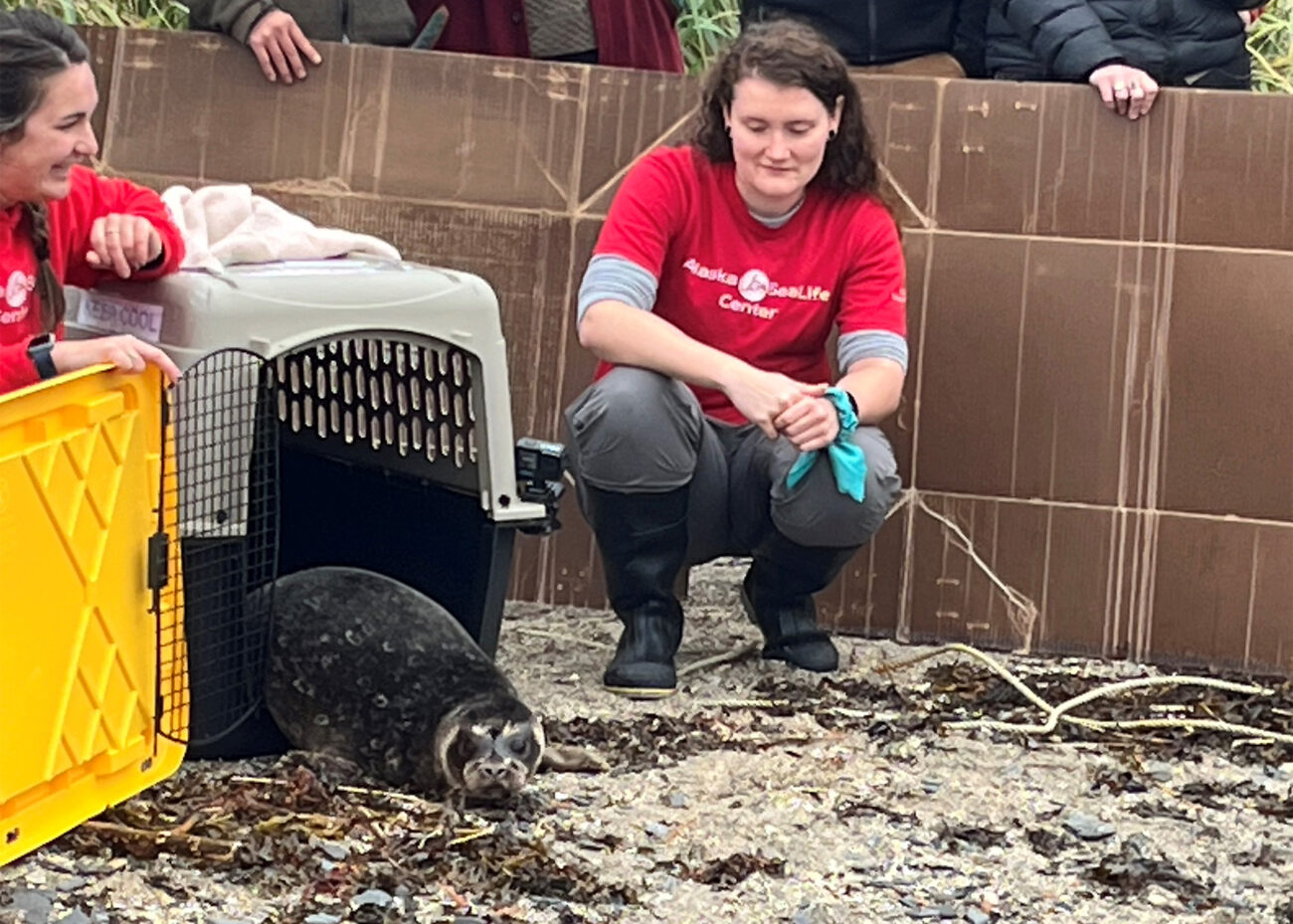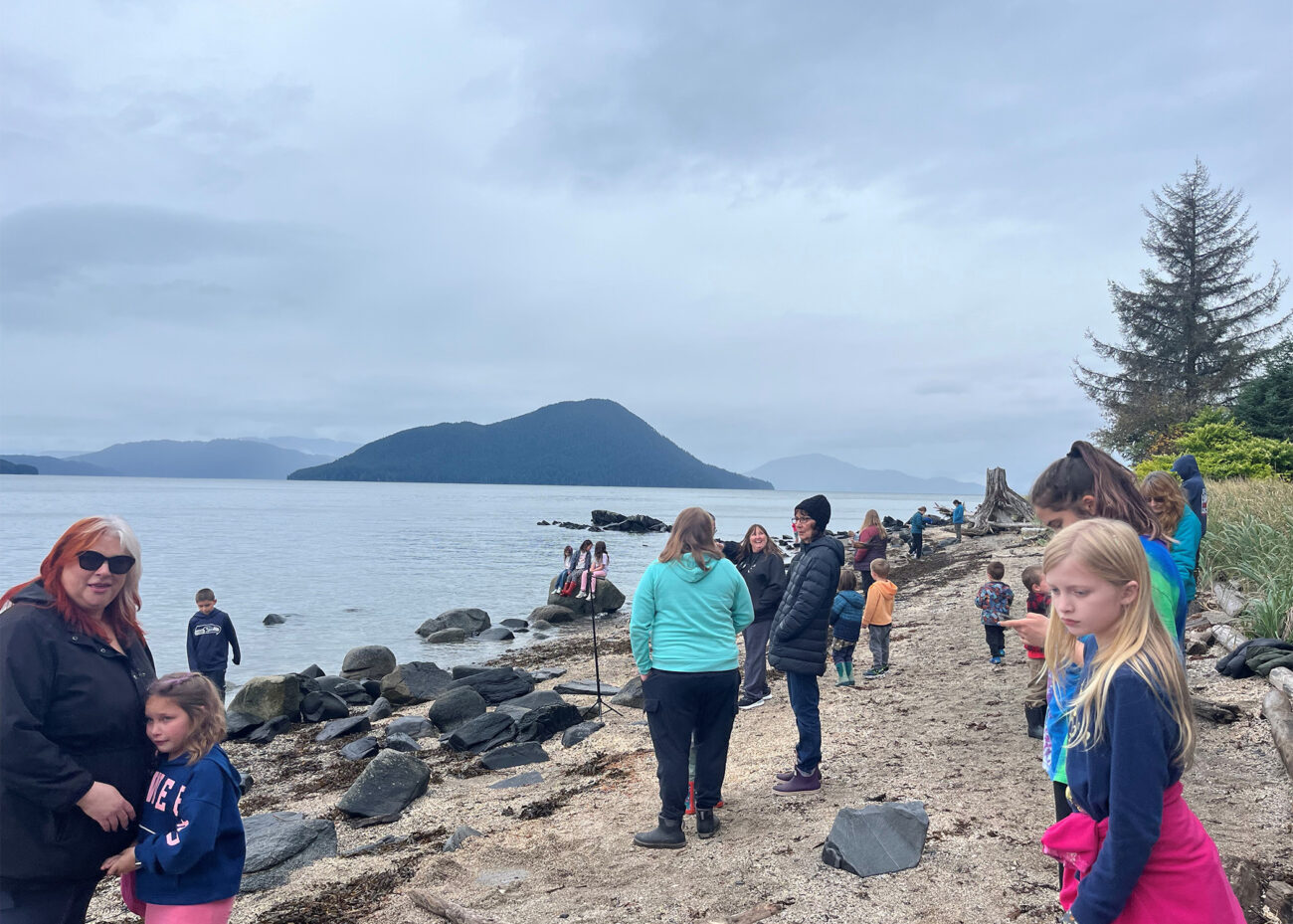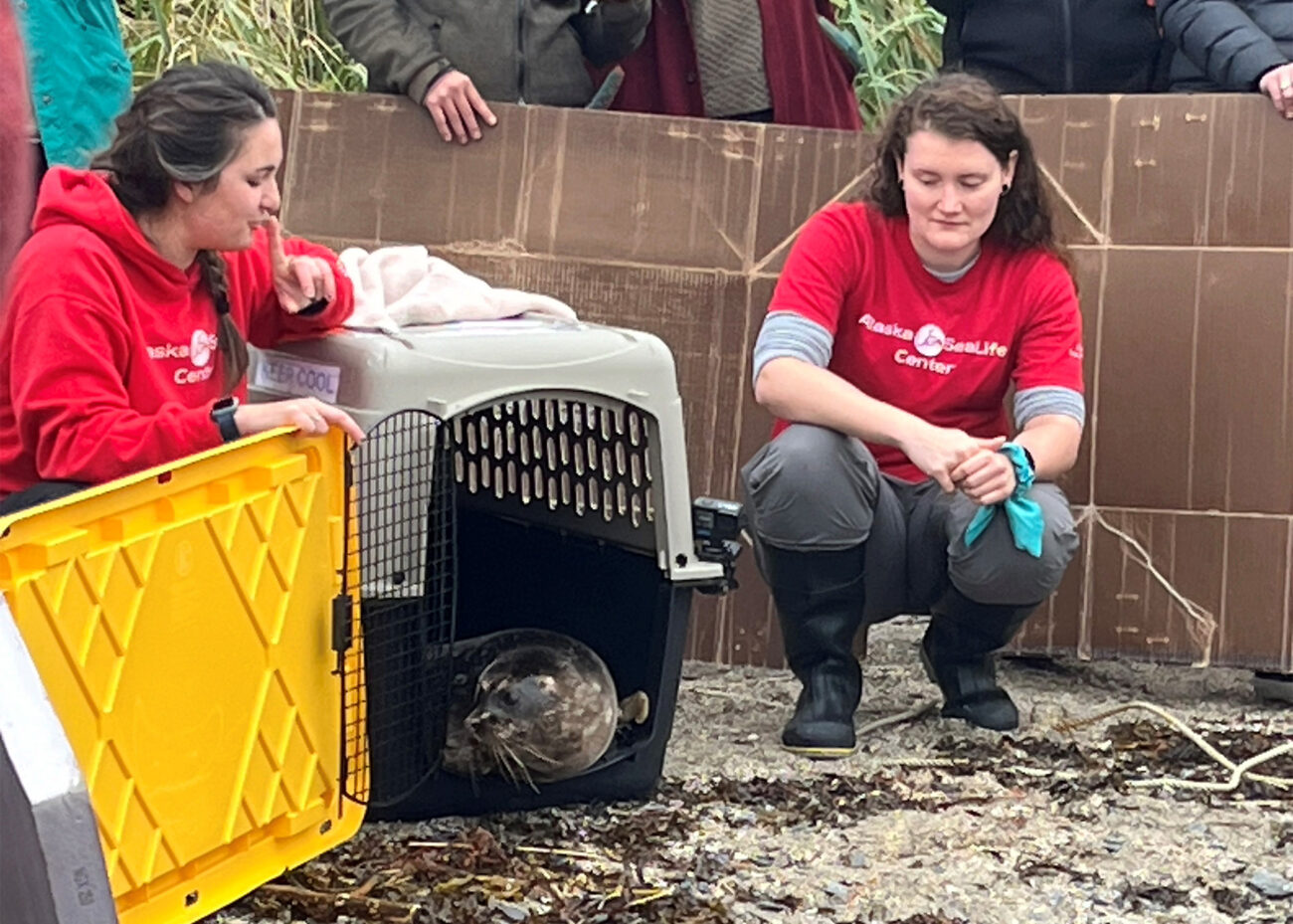
During a calm autumn afternoon, gentle lapping waves could be heard on Wrangell’s Petroglyph Beach, filled with shells, rocks and driftwood. Wrangellites gathered here earlier this month to watch a rescued and rehabilitated seal get released back into her natural habitat.
A baby harbor seal was found here on Petroglyph Beach back in June. She was just one week old and emaciated, wedged between some rocks. Some rescuers named her Rocky and flew her to the Alaska SeaLife Center in Seward the next day.
The Alaska SeaLife Center is a research facility, aquarium and wildlife response facility. The aquarium has fish and invertebrates. They also have octopii. Their collection mammals include stellar sea lions, harbor seals, spotted seals and ringed seals who went through the Wildlife Response Program and were deemed non-releasable.
As people waited for her return, seven-year- old Rooney Schaefer said she met Rocky the day she was rescued.
She said, “It got stuck under a rock and then they saved it.”
Schaefer said she’s excited to see Rocky off again and hopes she lives. Schaefer’s mom, Caity Rooney, said she helped take care of Rocky before she flew out.
“At first she was just kind of lethargic, you know? And then we gave her some subcutaneous fluid treatments,” Rooney said. “By the second one, you could tell she was feeling a little bit better, getting a little sassy. And then in the morning, like when we did the last one [subcutaneous fluid treatment] before we put her on the plane, you could tell she was feeling better and she kind of wanted to snuggle.”
She said she and her neighbor, Val Massie, would take Rocky out of the kennel and give her fluid treatments.
Normally seals aren’t affectionate with humans, but Rooney said that Rocky was.
“She let me rub her little tummy before she took off,” she said. “Seriously, if you can start your day petting a seal pup’s tummy, that’s gonna be a good day. She was just so fuzzy and soft. It was really something to be able to be part of it to help.”
She said that back in June Rocky was kept overnight outdoors in the kennel. That was the only way they could keep her cool during the warm June day.
“We took some pictures and stuff, and tried to just get her healthy so that she could make it back, survive the night and survive the flight up there,” she said.
Rooney said she’s very excited to see the little pup again.

“I can’t believe that I get to be here,” she said with the sound of gentle waves in the background. “Normally I’m still working at this time, but luckily, I had this afternoon kind of scheduled off. I’m glad that we get to be here and see her and see how she’s grown, and, you know, see how she’s doing.”
Soon after, a couple of helpers strung out a very long rope on the beach in the shape of a large V, with the wider part leading towards the ocean. The rope will show Rocky which way to go, plus it’s a boundary line between her and the spectators.
Wrangellite DaNika Smalley assisted by holding on to a large piece of cardboard to help out in case Rocky tries to cross the rope.
“If she tries to go towards people that they [the cardboard] can block her,” she said. “She won’t be able to see and what they said is that she has some personality to her, so I’m excited.”
With much anticipation, Alaska SeaLife Center employees carried Rocky to the beach in her kennel. Animal Care Specialist Savannah Costner had everyone gather along the V-line and gave the crowd instructions so the seal could move safely to the water without much fear.
“Today with me, we have what you guys have called Rocky,” Costner said. “Our naming theme this year was peppers and so we have named her Reaper after the Carolina Reaper pepper, because of her very spicy attitude. She is one of our spiciest seals that we’ve had this year.”
Yes, Rocky has multiple names now – Rocky, Reaper, even number 13. To avoid confusion, we’ll stick with Rocky.
Costner said that when they first saw Rocky she was very skinny and had tremors. She also had no ring markings around her eyes, indicating dehydration.
“By the time we got her to Seward, those tremors had actually progressed and she was a little bit unresponsive,” she said. “She did take to the emergency life saving IV medications really well. She was found to be dehydrated and underweight.”
Now, Rocky’s no longer underweight. The SeaLife Center plumped her up and she’s double the weight of what she was. When she came to the center she was just under 44 lbs, now she’s just over 121 lbs.
Costner said that all they want is for Rocky to be out in the ocean – and the sooner they can do that, the better it is for the seal.
“She is actually turned around in the kennel right now,” she said. “This is the most amount of people that she has ever seen in her entire life. Okay? So when we go to open that kennel door, I would like for everyone to be very quiet. We don’t want to scare her.”
Rocky hesitated at first. She poked her head out and looked left and right. Everyone was quiet. And then Rocky took her first few galumphs – or flops – along the beach towards the water. Her galumphs were rhythmic, like if someone swooshing sand up as they quickly walk. The only difference is that Petroglyph Beach is mostly filled with shells and stones; not a sandy beach.
She’s very dark in color with a marbling of lighter shades. And this time she does have dark rings around her eyes. As she galumphed, you could see a slight wave of her blubber.
Once she reaches the ocean, her galumphs splashed the water and she submerged her body in the water. But she didn’t just swim away. She looked around at everyone behind her.
Little kids were yelling bye to her. It was one of the last moments that Rocky and the spectators took in the scene on the beach.
Maddie Welch, a seasonal contractor with the Alaska SeaLife Center, said she has high hopes for the seal.
“We feel really good about her chances,” she said. “She’s been the spiciest, most aggressive from day one. Like she was down and out and still wanted to rip your face off.”
She said that Rocky is her favorite but releasing her back into the wild is the best case scenario for her. She’s been very solitary at the center, Welch said.
“She didn’t really interact with anybody else at our facility and so there’s a chance for her to interact with other seals out here,” Welch said. “But they don’t like group up and form relationships.”
Welch said that after they got over the first couple of days at the center, Rocky was on the mend and made great strides.
“She was one of our first to catch on to fish school, where they kind of teach themselves that they should be eating fish,” she said. “So we kind of transitioned them from formula to fish.”

She said that the SeaLife Center makes sure that their rehabilitated marine mammals are at an ideal weight before releasing them back into the wild.
“We tend to plump them up a little bit more to give them a better chance out against the winter,” Welch said. “So she’s definitely on the more plump side of normal.”
Welch said that when it comes to release, they have different criteria that they check off to ensure the marine mammals can thrive in the wild. The first is passing fish school.
“She’s showing us that she’s able to forage and find and hunt live herring, as well as continuously eat dead herring,” she said. “So we’re giving her fish and she’s able to catch them and kill them and eat them. She’s got to have a clear medical record from our veterinarians.”
The last criteria is that she had to be signed off by the National Oceanic Atmospheric Administration.
To prep Rocky for flying, she said that they didn’t sedate her.
“We fasted her for a little bit just to make sure she had that hunger drive, so she was set up for success when she comes out here,” Welch said. “We found historically that has worked best for our patients.”
Other than that, they put her in the kennel and tried to reduce the stress as much as possible. Welch said that they tend to be ok with shorter distance flights and don’t need medication.
Rocky’s future might not be known – she’s not being tracked – but she does have a blue tag on her flipper.
“If you see any dark seal that’s tagged, it’s probably her, but it has a 199 on it,” Welch said. “We love to hear from people calling in. We have a 24/7 hotline, and so people can call in and tell us that, ‘Hey, I saw a dark seal in Wrangell.’ It was probably her and so we can kind of keep track of her that way.”
Harbor seals can be tan, silvery white, grey and brown. Welch said that Rocky’s a dark morph harbor seal.
“Typically, harbor seals are kind of that gray and black, like splotchy, spotted,” she said. “She’s almost jet black when she’s wet, so she is kind of a darker morphologic of that harbor seal. She’s not her own species or anything like that.”
She said that the center has had different dark morphs and they tend to see a lot more coming from Southeast Alaska.
The waves on the beach still had the gentle soothing murmur after Rocky swam a short distance away. She returned a few times, popping her head up out of the water and looking at everyone. Eventually though, she swam farther into her natural territory and off to do what seals do to survive.











